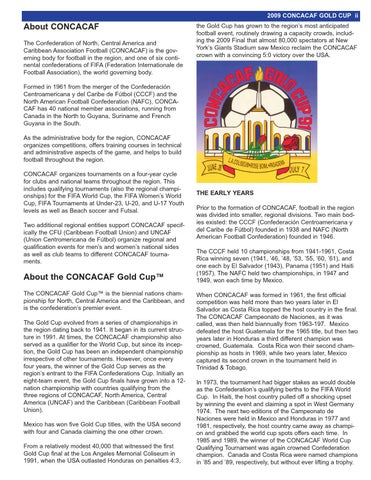About CONCACAF
The Confederation of North, Central America and Caribbean Association Football (CONCACAF) is the governing body for football in the region, and one of six continental confederations of FIFA (Federation Internationale de Football Association), the world governing body.
2009 CONCACAF GOLD CUP ii
the Gold Cup has grown to the region’s most anticipated football event, routinely drawing a capacity crowds, including the 2009 Final that almost 80,000 spectators at New York’s Giants Stadium saw Mexico reclaim the CONCACAF crown with a convincing 5:0 victory over the USA.
Formed in 1961 from the merger of the Confederación Centroamericana y del Caribe de Fútbol (CCCF) and the North American Football Confederation (NAFC), CONCACAF has 40 national member associations, running from Canada in the North to Guyana, Suriname and French Guyana in the South.
As the administrative body for the region, CONCACAF organizes competitions, offers training courses in technical and administrative aspects of the game, and helps to build football throughout the region.
CONCACAF organizes tournaments on a four-year cycle for clubs and national teams throughout the region. This includes qualifying tournaments (also the regional championships) for the FIFA World Cup, the FIFA Women’s World Cup, FIFA Tournaments at Under-23, U-20, and U-17 Youth levels as well as Beach soccer and Futsal.
Two additional regional entities support CONCACAF specifically the CFU (Caribbean Football Union) and UNCAF (Union Centromericana de Fútbol) organize regional and qualification events for men’s and women’s national sides as well as club teams to different CONCACAF tournaments.
About the CONCACAF Gold Cup™
The CONCACAF Gold Cup™ is the biennial nations championship for North, Central America and the Caribbean, and is the confederation’s premier event.
The Gold Cup evolved from a series of championships in the region dating back to 1941. It began in its current structure in 1991. At times, the CONCACAF championship also served as a qualifier for the World Cup, but since its inception, the Gold Cup has been an independent championship irrespective of other tournaments. However, once every four years, the winner of the Gold Cup serves as the region’s entrant to the FIFA Confederations Cup. Initially an eight-team event, the Gold Cup finals have grown into a 12nation championship with countries qualifying from the three regions of CONCACAF, North America, Central America (UNCAF) and the Caribbean (Caribbean Football Union). Mexico has won five Gold Cup titles, with the USA second with four and Canada claiming the one other crown.
From a relatively modest 40,000 that witnessed the first Gold Cup final at the Los Angeles Memorial Coliseum in 1991, when the USA outlasted Honduras on penalties 4:3,
THE EARLY YEARS
Prior to the formation of CONCACAF, football in the region was divided into smaller, regional divisions. Two main bodies existed: the CCCF (Confederación Centroamericana y del Caribe de Fútbol) founded in 1938 and NAFC (North American Football Confederation) founded in 1946. The CCCF held 10 championships from 1941-1961, Costa Rica winning seven (1941, ’46, ’48, ’53, ’55, ’60, ’61), and one each by El Salvador (1943), Panama (1951) and Haiti (1957). The NAFC held two championships, in 1947 and 1949, won each time by Mexico.
When CONCACAF was formed in 1961, the first official competition was held more than two years later in El Salvador as Costa Rica topped the host country in the final. The CONCACAF Campeonato de Naciones, as it was called, was then held biannually from 1963-197. Mexico defeated the host Guatemala for the 1965 title, but then two years later in Honduras a third different champion was crowned, Guatemala. Costa Rica won their second championship as hosts in 1969, while two years later, Mexico captured its second crown in the tournament held in Trinidad & Tobago. In 1973, the tournament had bigger stakes as would double as the Confederation’s qualifying berths to the FIFA World Cup. In Haiti, the host country pulled off a shocking upset by winning the event and claiming a spot in West Germany 1974. The next two editions of the Campeonato de Naciones were held in Mexico and Honduras in 1977 and 1981, respectively, the host country came away as champion and grabbed the world cup spots offers each time. In 1985 and 1989, the winner of the CONCACAF World Cup Qualifying Tournament was again crowned Confederation champion. Canada and Costa Rica were named champions in ’85 and ’89, respectively, but without ever lifting a trophy.
